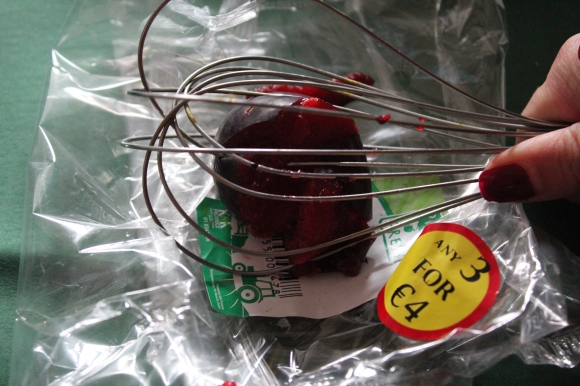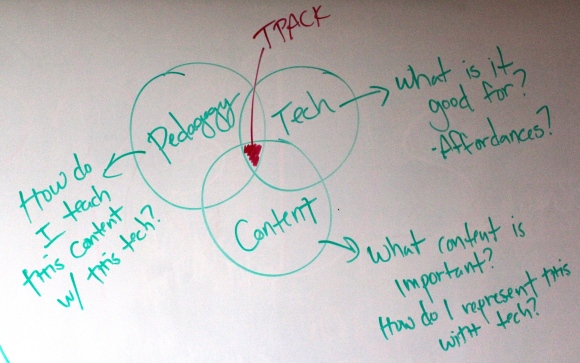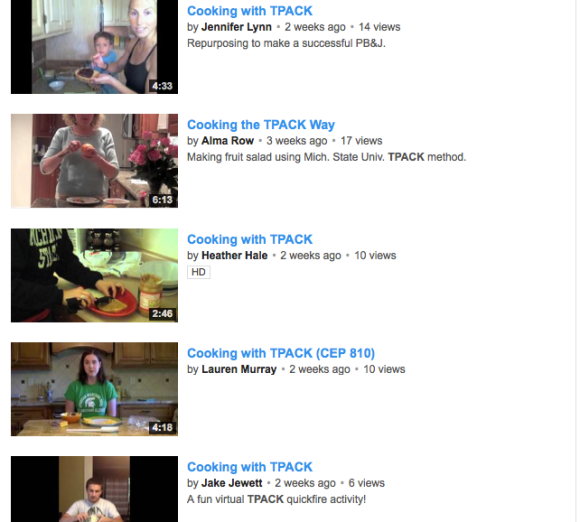I just today had one of those moments that made me really, really happy to be doing the work I do.
In the summer of 2011, I took a chance on the development of a creative introduction to TPACK (Koehler & Mishra, 2008; Mishra & Koehler, 2006) for MAET students that I knew, if done well, would be fun, memorable and might even support students’ understanding of the complexities of teaching with technologies. If done poorly, however, I knew that it would be an epic fail, memorable for all the wrong reasons. (Oh — and +1 risk because Punya Mishra was my boss.)
I named the activity Cooking with TPACK. The premise was simple. By having students do a familiar kitchen task with familiar tools that were or were not especially well suited to the task, I would leverage metaphorical thinking as a bridge to more abstract understanding of TPACK.
Before students walked into class, they selected a kitchen tool from among those laid out on a table – a whisk, a wooden spoon, a can opener, a butter knife, a vegetable peeler, a teaspoon. Next, students selected a random number from a hat. The number corresponded to a center that had been set up in advance. Students worked in pairs. At each center, there were ingredients, a bowl or plate of generally inappropriate proportions for the task, and instructions. Make a fruit salad. Slice bread. Mix yogurt and honey. Make whipped cream. The trading of tools was not allowed [insert firm teacher voice here].
 The students set about their tasks and immediately, the laughter began. Cutting plums with a whisk is pretty funny. The juice squirts all over and the end result is a bit of a mush. It was easy for students to understand the obvious lesson about the repurposing of tools. Though difficult, one can slice peaches with a teaspoon. Everyone was envious of the student who picked the knife — except that she had to make whipped cream and it was of little use. If the bowl is too small to accomodate all of the yogurt, you have to think differently about the task. That particular realization brought about a great conversation that focused on the context in which all of our “tool use” occurs.
The students set about their tasks and immediately, the laughter began. Cutting plums with a whisk is pretty funny. The juice squirts all over and the end result is a bit of a mush. It was easy for students to understand the obvious lesson about the repurposing of tools. Though difficult, one can slice peaches with a teaspoon. Everyone was envious of the student who picked the knife — except that she had to make whipped cream and it was of little use. If the bowl is too small to accomodate all of the yogurt, you have to think differently about the task. That particular realization brought about a great conversation that focused on the context in which all of our “tool use” occurs.
In general, the conversations that ensued about TPACK were incredibly charged and powerful. By deconstructing the parts of the framework, we constructed an understanding of its meaning, and also of its implications for teachers using technologies in classrooms.
 Technology — that was obviously the tool, but also the ways that a tool can be used. As the students deduced immediately, you can have the right tool for the task, or a tool that you have to repurpose to get the job done. When repurposed, some tools work better than others. It’s also surprising how they never noticed all of the ways to use a vegetable peeler.
Technology — that was obviously the tool, but also the ways that a tool can be used. As the students deduced immediately, you can have the right tool for the task, or a tool that you have to repurpose to get the job done. When repurposed, some tools work better than others. It’s also surprising how they never noticed all of the ways to use a vegetable peeler.
Content — that was the task. Make a fruit salad or whipped cream.
Pedagogy — that was the technique. This was the set of possible methods one could use to accomplish the task. And for the fruit salad group, they also had to think about pedagogies/techniques for each of the fruits that laid before them on the table. Do you cut a banana the same way you cut a plum or an apple? These questions became obvious as the activity progressed.
Reflecting on their experiences, students considered the interactions of all variables and, in the end, came to understand that characteristics of the task/content, tool/technology, and the pedagogy/techniques constrained options but also afforded creative solutions. They recognized how the food itself (i.e., the students) possessed different properties that required different techniques/pedagogies but would also have benefitted from different technologies. That plum would have been way less mush had it been cut with a knife rather than a whisk. The banana on the other hand, didn’t mind the whisk so much.
As they ate the breakfast they had just made for one another, they considered the aesthetic quality and the taste of the food. Maybe it didn’t look the way fruit salad usually looked, but did it taste as sweet? Their minds and tummies were full.
Two years on, I’m so pleased that this activity has now been adapted for online, on-campus and overseas students in the MAET program — and most of all, that students and teachers all seem to have embraced the spirit of the fun that inspired the idea in the first place.
So, what was that happy moment?
Well, a quick search today on YouTube of “cooking with TPACK” returned more than a dozen videos of teacher colleagues engaged in this activity from their home kitchens.
[happy dance]
Dream. Come. True.
References
Koehler, M. J., Mishra, P., & AACTE. (2008). Introducing TPCK. In AACTE Committee on Innovation and Technology (Ed.), Handbook of Technological Pedagogical Content Knowledge (TPCK) (pp. 3–29). New York: Routledge.
Mishra, P., & Koehler, M. J. (2006). Technological Pedagogical Content Knowledge: A Framework for Teacher Knowledge. Teachers College Record, 108(6), 1017–1054. doi:10.1111/j.1467-9620.2006.00684.x

3 responses to “Cooking with TPACK”
And you’ll soon see more! I am in Ian O’Byrne’s program at the University of New Haven and our class has the “Cooking with TPACK” assignment due next week. I’m looking forward to it. Thanks for coming up with this creative way to deepen our understanding of TPACK and for sharing some examples.
Hi Tim! Thanks for your note! It’s so fun to think that you’ll be giving this activity a go this week! I would LOVE to see photos or video or any insights you gain re: technology integration from the activity. Are you doing this in class? Or online? Either way — I really hope you enjoy it!
[…] Cooking with TPACK by Michelle Schira Hagerman (updated link after roundtable) […]